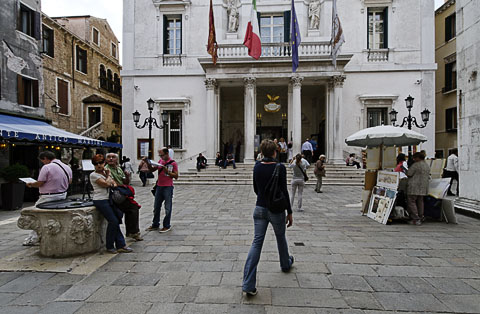
|
||
|
Issue 73 |
|
10 April 2014 |
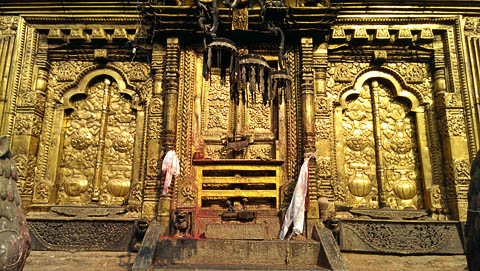 Brass work at Changu Narayan temple near Bhaktapur, Nepal. Changu Narayan is a delightful town, and the old part is carfree. 2014 J.H. Crawford AnnouncementsThis issue is rather late due to the complexity of establishing life in Bhaktapur, Nepal. We should be back on schedule for the next issue.
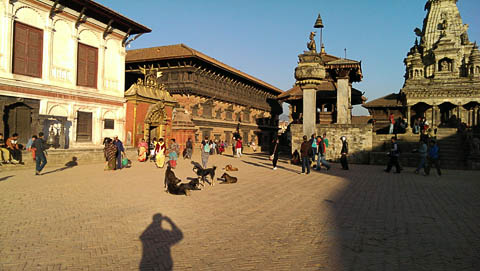 Bhaktapur's Durbar Square near sunset 2013 J.H. Crawford Carfree InstituteCarfree.com has relocated to Bhaktapur, Nepal, an ancient city located just 13 kilometers east of Kathmandu, the capital of Nepal. The city's population of about 80,000 is densely housed in streets and buildings that closely resemble the Reference Design for carfree cities. Most houses border on a narrow street and on an interior courtyard of appreciable size. Most of the houses are three or four stories tall.The Institute is housed in a modern "pillar building" made predominately of reinforced concrete. These buildings are not as attractive as the traditional buildings but are expected to fare much better in the earthquakes that often strike in this region. We have been very busy with infrastructure, and this issue of Carfree Times is the first significant work since Carfree.com departed from Summit, New Jersey in the USA three months ago. We are about to turn our focus to the Institute's activities and affiliations, but the buildup of the Institute may take as much as a year. We are looking forward to a productive cooperation with RECPHEC, a Nepali NGO located in Kathmandu that is dedicated to improving public health through a variety of measures, most definitely including a reduction of the health impacts of the transport sector. We will be helping RECPHEC to bring carfreedom to the Thamel area of Kathmandu. Stay tuned for developments.
The BooksCarfree Cities and Carfree Design Manual are widely available from booksellers in Europe and North America. |
|
VideoThe production of new videos will be a primary task of the Carfree Institute, but this will take some time to come to fruition. In the meantime, the existing 30 videos continue to draw views. You can find them all here:Vimeo (recommended) YouTube (not all videos are here) However, the best way to watch is probably to use my new channel at Vimeo: which allows me to present the newest and best videos first. If you watch a video, please Like it by clicking the Heart icon in the top-right of the video frame (Vimeo) or clicking the Thumbs Up icon below the video (YouTube). Posting to social media would also help.
|
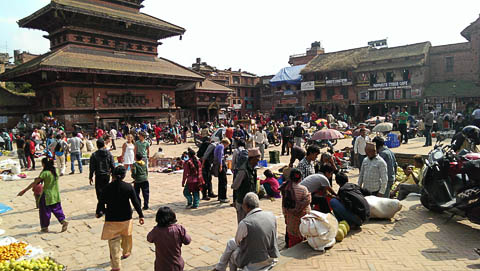 Taumadhi Square in Bhaktapur during the Tihar festival 2013 J.H. Crawford World Carfree NetworkCarfree.com actively supports World Carfree Network (WCN), which lacks funding and is currently dormant.The degrowth movement has some of its roots in the early Towards Carfree Cities (TCFC) conferences organized by what later became World Carfree Network. The Fourth International Degrowth Conference will be held in Leipzig, Germany, September 2-6, 2014. Elly Blue, one of the organizers of the TCFC conference in Portland, Oregon, a few years back, recently published Bikenomics, an examination of the economics of various transport modes and the place of the bicycle in our transport network. Now the first chapter of her book is available online. |
News BitsThe photographs below were taken in late 2013, all within 30 kilometers of Bhaktapur. The links below will open in a new browser window (crtl + left-click to open in a new tab instead):
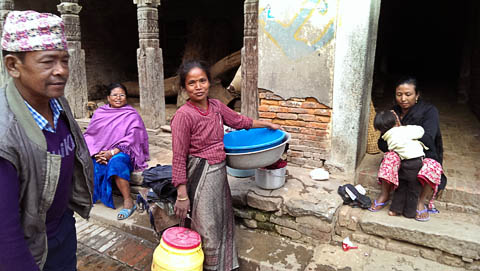 Street life in Bhaktapur 2013 J.H. Crawford
"Nasa-funded study: industrial civilisation headed for 'irreversible collapse'?"
The project investigated the dynamics of interactions between humans and nature in historical collapses. The principal risk factors are population, climate, water, agriculture, and energy. We are vulnerable on all these fronts. Economic stratification is a further large risk factor that is associated with resource overconsumption. Technology offers no panacea: "Technological change can raise the efficiency of resource use, but it also tends to raise both per-capita resource consumption and the scale of resource extraction." This phenomenon was first noticed in 1865 by William Stanley Jevons, who observed that the increasing efficiency of steam engines had led to large increases in the consumption of coal. Excessive resource exploitation leads to an early decline of the poor, even as the elites are thriving. Eventually the poor collapse completely, followed by the elites. The scientists did point out that the worst-case scenarios are not inevitable and suggest that a range of changes could avoid collapse. "Collapse can be avoided and population can reach equilibrium if the per-capita rate of depletion of nature is reduced to a sustainable level, and if resources are distributed in a reasonably equitable fashion." The study is largely theoretical, but others have warned that the convergence of food, water, and energy crises can result in widespread calamity in just fifteen years. (Economist.com) 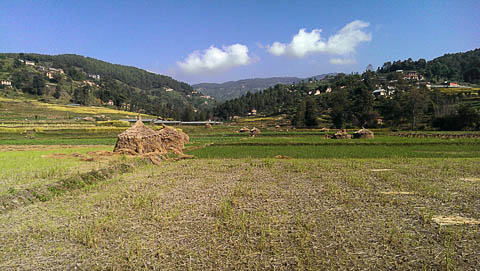 Fields and hills a few kilometers outside Bhaktapur 2013 J.H. Crawford
"Climate engineering: Minor potential, major risk of side-effects?"
As usual, the right thing to do is to bring CO2 emissions down rapidly all around the world except in the poorest areas, where they have always been low and where people's very survival may depend on the burning of small amounts of fossil fuel for cooking. (ScienceDaily.com) 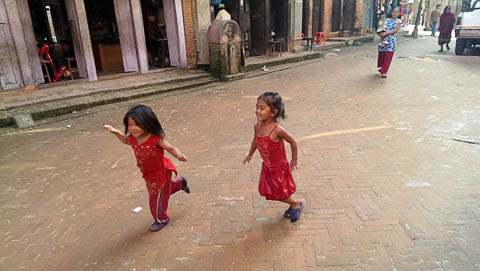 Girls playing in the street in Bhaktapur 2013 J.H. Crawford
"Will the Cities of the Future be Car-free Zones?"
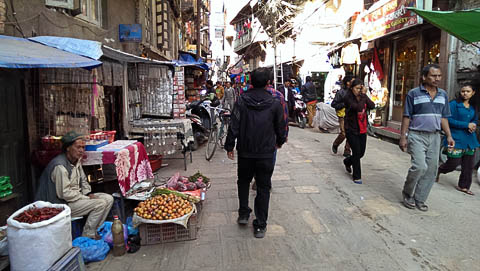 The Thamel district in Kathmandu, Nepal 2013 J.H. Crawford
"Europe's Most Congested City Contemplates Going Car-Free"
From the 1958 World's Fair up until the early 1970s, Brussels was notorious for leveling entire city quarters for office block construction. The pedestrian plan will also help to reunite the city's touristy but magical medieval core with the hipper areas. A recent survey of 3500 people by Le Soir found 61% favoring the changes. (TheAtlanticCities.com) 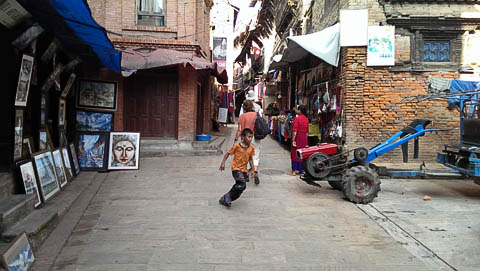 A boy runs past one of many tractors in Bhaktapur 2013 J.H. Crawford
"Scientific Proof That Cars and Cities Just Don't Mix"
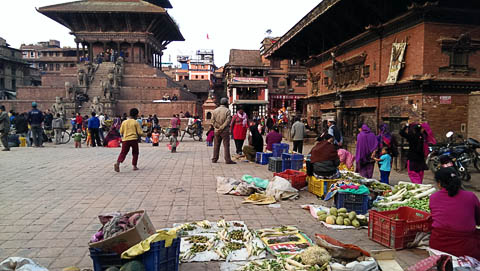 Taumadhi Square in Bhaktapur 2013 J.H. Crawford
"6 Freeway Removals That Changed Their Cities Forever"
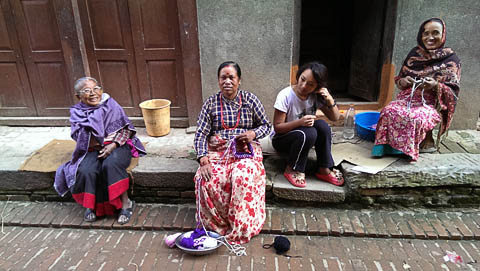 Knitting and chatting on the street in Bhaktapur 2013 J.H. Crawford
 Stores spill out into the street in Bhaktapur 2013 J.H. Crawford
"Warm Arctic, Cold Continents:
Changes in the Arctic Are Hitting Closer to Home"
Many factors can produce extreme weather events, but the potential impact from Arctic regions is great when solar heat absorbed by newly ice-free regions of the ocean warms the atmosphere during autumn, changing prevailing winds. (NOAA.gov) 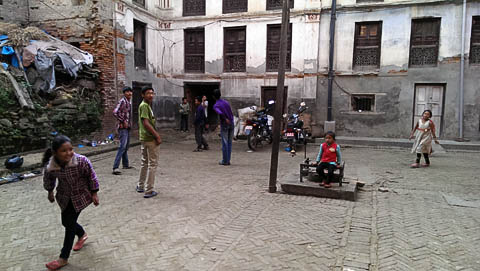 Kids playing in one of the many interior courtyards, Bhaktapur 2013 J.H. Crawford
"Unclean at Any Speed: Electric cars don't solve the automobile's environmental problems"
Widespread adoption of electric vehicles may have negligible effects on greenhouse gas emissions. Much depends on the source of the electricity used to recharge the batteries. Electricity from nuclear power may have a low direct impact on greenhouse gases, but the secondary energy required to build, fuel, and dismantle nuclear power plants is difficult even to estimate, and the effects of rare accidents are overwhelming, as we are seeing at Fukushima. Even the production of photovoltaic cells involves the use of chemicals with potent greenhouse gas effects, and large amounts of fossil fuel are consumed. The energy embodied in the vehicle is larger than in a conventional fossil-fueled car. The use of exotic materials is a further problem that arises mainly from their energy-intensive extraction and production. One study concluded that "an electric car is likely worse than a car fueled exclusively by gasoline derived from Canadian tar sands!" It doesn't get much worse than that. Most academic programs related to electric vehicles are funded by the auto industry. "Indeed, it's very difficult to find researchers who are looking at the environmental merits of electric cars with a disinterested eye." It is a mark of integrity that this article appeared in the principal journal of electrical engineers. Bottom line: there are no green cars. (IEEE Spectrum) 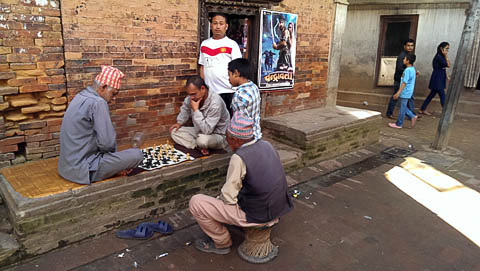 Playing chess on the street in Bhaktapur 2013 J.H. Crawford
"Teslas in California Help Bring Dirty Rain to China"
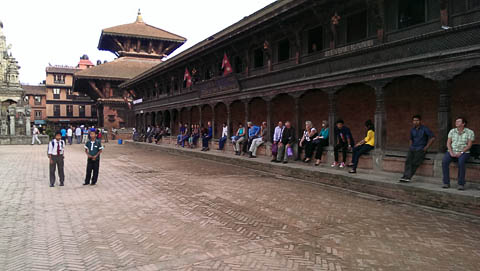 Durbar Square in Bhaktapur, showing places for people to sit 2013 J.H. Crawford
"The Largest Free Mass Transit Experiment in the World"
Local support has been strong, with 90% saying they like the change. What's not so clear is that commuting behavior has changed very much. Some researchers found just a 3% increase in ridership and that the no-fare system accounted for less than half that gain. There is evidence of social benefits in the form of improved access to the city. The real benefits of fare-free transit are often overlooked and in fact do not exist in Tallinn. The simplifications of not having to carry change or a fare card and not having to check in and out are wonderful for riders and save the transit agency quite a lot of money directly, by eliminating the costs of fare collection, and indirectly, by enabling shorter trip times. (TheAtlanticCities.com) 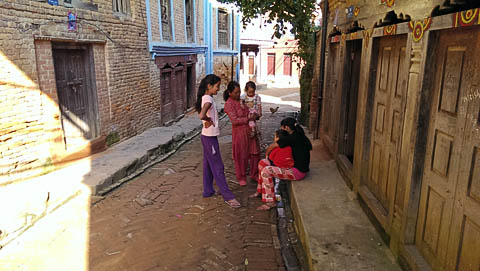 People enjoying the streets of Panauti, Nepal 2013 J.H. Crawford
"You Pays Your Money, and You Takes Your Choice"
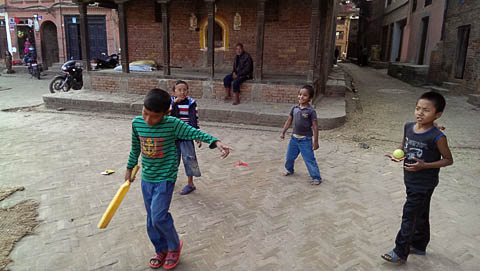 A dispute over cricket in Bhaktapur 2013 J.H. Crawford
"3 Enormous Benefits to Charging the Right Price for Parking"
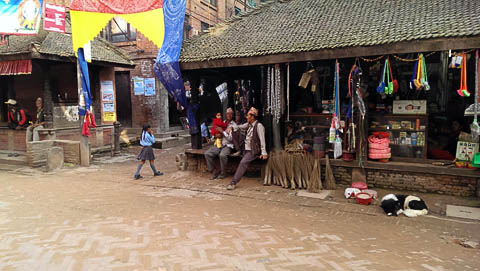 Bhaktapur has many spots that invite people to linger 2013 J.H. Crawford
"Norman Foster unveils plans for elevated 'SkyCycle' bike routes in London"
The right approach is to get the cars off the streets; then there's plenty of room for cyclists and buses. The cost of the proposed plan would be quite high - a 6.5km trial route would cost around £220 million. Part of the cost relates to the "installation of vertical hydraulic platforms next to existing railway stations," which sounds like some kind of elevator. (Guardian.co.uk) 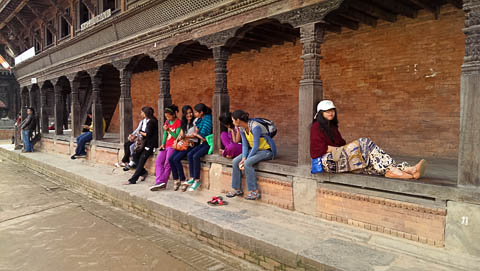 Lounging on Durbar Square, Bhaktapur 2013 J.H. Crawford
"Murder Machines: Why Cars Will Kill 30,000 Americans This Year"
"If you look at newspapers from American cities in the 1910s and '20s, you'll find a lot of anger at cars and drivers, really an incredible amount," says Peter Norton, the author of Fighting Traffic: The Dawn of the Motor Age in the American City. "My impression is that you'd find more caricatures of the Grim Reaper driving a car over innocent children than you would images of Uncle Sam." 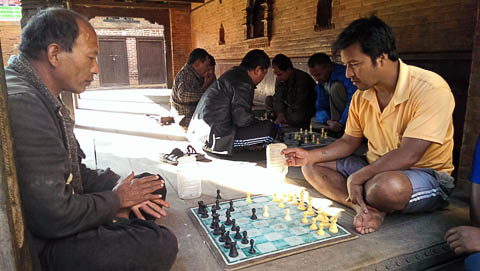 Playing chess in one of the streetside shelters in Bhaktapur 2013 J.H. Crawford
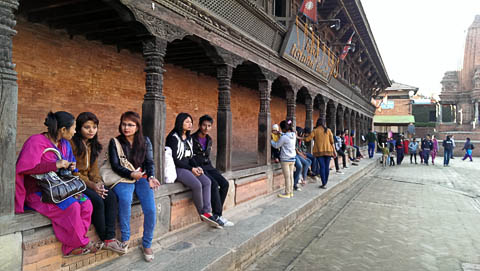 Hanging out on Durbar Square, Bhaktapur 2013 J.H. Crawford
"States Reinvest in Once-Abandoned Freight Lines"
Rail began to decline in the late 1940s, and the industry lost political clout. The decline was accelerated by federal spending on highway construction starting in the 1950s. Stringent regulation of the railroads made it difficult for them to compete with trucking. By the 1960s, thousands of miles of lines were being abandoned by major railroads, many of which went bankrupt in the 1970s. Rail began a slow comeback starting in 1980, when freight railroads were allowed to compete not only with each other but with other forms of transportation. Small regional and short-line railroads emerged to pick up ancillary track around the country. Rail service is finally being recognized for the many benefits it offers, including economic efficiency and low emissions per ton-mile. An industry insider says, "The country needs rail transportation perhaps more now than ever. The question is will government support what is a major solution to overcrowded highways and aging infrastructure?" (Governing.com)
Back to Carfree.com
E-mail
|
